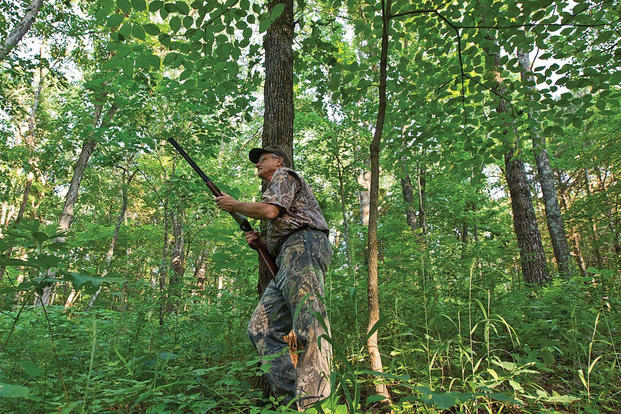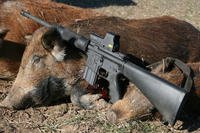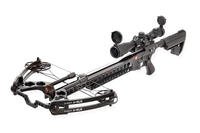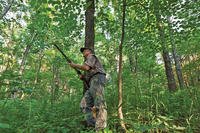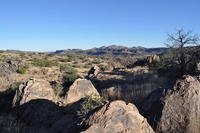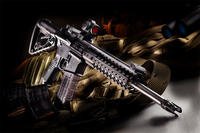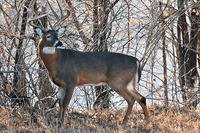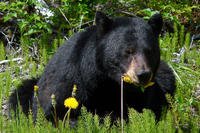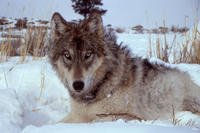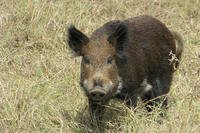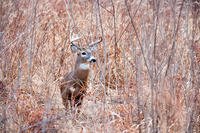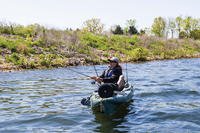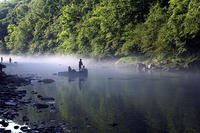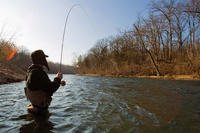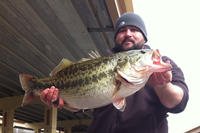By Andrew Lewand
Quick Change Snow Camo
From the clothes rack, I chose a white camo coverall along with white gloves and hat. Blending in with the surroundings is paramount to success when calling wary Eastern coyotes. You can obtain snow-pattern camo clothing easily. Specialty hunting stores and Internet Web sites or catalogs carry hats, gloves, facemasks, jackets and pants. It’s a wise decision to store a white camo shell jacket in your vehicle. This way — in case of sudden snow — you can wear the shell over traditional camo, and this will help you blend in with the white landscape.
Snow hunters also need to pay attention to accessories. Firearms, calls, decoys, shooting sticks and chairs should match the white environment for maximum effect. This begs the question, “Who wants to purchase two sets of accessories to hunt when there is snow or no snow?”
Even applying white paint to accessories has its drawbacks. Frequently there are situations when you need snow camo and then — even in the course of the same hunt — traditional camo would be more beneficial. To deal with this, use white cloth sports tape. You can easily apply and remove the tape as needed, and it leaves absolutely no residue.
My rifle has a black synthetic stock. By applying stripes of white sports tape, the tape hides the outline of the rifle, including scope. The tape is matte finish, thus preventing glare.
White tape also adorns the bottom portion of my call and decoy to meld into the snow. I store a Mossy Oak bandana inside the call for use on days when snow is not present. Simply cut a small hole in the bandana and drape it over the antenna or decoy wire and presto… instant concealment!
If your digital call stands out like a sore thumb against the snow, cover the call with white fabric like a small towel or even a child’s winter hat. Make a hole for the antennae and speaker and the call is now “dressed for success,” but you can instantly convert your call to non-snow use if need be.
Paying attention to removable snow camo solutions will make your predator calling more successful. The materials needed are not costly, and you can obtain them in any department store. For maximum concealment and convenience, try quick-change snow camo.
Develop The Rabbit Habit
By J. Michael Klemens
For trapping sets and predator calling, I use a great homegrown fear remover that works equally well in snow as in dirt. I use the droppings, urine and hair from domestic rabbits as a fear remover, a curiosity scent, and a distracter.
You can easily collect the items. The most difficult part is finding someone who raises rabbits. Ask around at feed stores, and you’ll find a source. Better yet, raise some yourself and have some tasty meals as well. One rabbit yields more material than you need.
To collect droppings and urine, use trays or pans beneath the cages. On a daily basis, empty the pans of urine into small screw-top bottles, leaving room for freeze expansion. You can place the pellets in plastic baggies, which is the amount you’ll need for a set, then freeze them. To obtain loose hair, check the fluffy nests made by the female for her nest. You can also cut strips of hair from the dried skin of butchered rabbits — domestic or wild. Bag loose hair and hair strips. Set urine and pellets out to thaw the night before a hunt. Don’t microwave or heat to thaw.
For predator callers, the rabbit parts serve a unique purpose. You need to attract, distract and occupy the attention of the animal that believes it is moving in for an easy meal. A strip of rabbit hair suspended and moving with the wind helps fulfill all these needs.
On the anticipated line of approach, choose a site or two for scatterings of pellets, urine and loose hair to give your prey something to hone in on. Scatter some around your remote caller and/or decoy to add absolute realism to your set.
Reflect On This!
By Andrew Lewand
Losing gear in the darkness is something that happens to all of us, unless you know the trick. Place reflective red tape on electronic calls, shooting sticks and chairs. The tape, originally intended for taillight repair, is inexpensive, and you can purchase it at any auto store or auto department.
Place a strip of tape on the antennae of your electronic call, and you will always be aware of its location while scanning with lights. This is handy before and after a calling session.
Prior to calling, locate the call in the red glow of the spotlight and adjust the intensity of the light beam accordingly. Light beam intensity needs to vary from night to night, depending on atmospheric conditions. It is nice to have something with which to “test” your brightness before calling.
After a calling session, shine your light, and the tape will act as a beacon for quick call retrieval. No more wasting time and precious battery life searching for remotely placed calls.
You should also place reflective tape on your shooting sticks and seat. I’ll bet I’m not the only hunter who has raced across a field after hearing the tell-tale “whump” of a predator just shot, only to realize that I couldn’t get back to my stool and shooting sticks. Oh sure, you eventually find them, but you lose precious minutes of hunting time due to the search.
Reflective tape ensures quick equipment retrieval and prevents wandering around wasting battery life and giving any game in the area a look at your flashlight waving around while trying to locate gear.
Trail Cameras for Coyotes
By Matt Schroderus
You can't spend 24 hours a day scouting the woods, but you can do the next best thing — set up a trail camera. With proper location and set up, a predator hunter can scout an area for weeks on end and get an idea of just what’s out there before he commits the time to hunt.
Location
Find a suitable location to place your camera. Coyotes are territorial animals that often use the same paths. Places such as valleys, old stream beds and logging roads are common travel routes. Another good location is near beaver dams between wet areas. Many animals, including coyote, prefer to keep their feet dry when possible. In desert country, a water hole is perfect.
Where legal, you can add some types of food as bait, such as road kill or table scraps. It may take time to lure in the predators, but it’s hard for them to pass up a free meal. When using a food source, be aware that coyote aren’t the only ones looking for a free meal. You frequently get a variety of animal pictures. Last winter, I set out a camera by a deer rib cage leftover from hunting season. The animals captured by the camera included a pine marten, fisher, weasel, skunk, jays, crows — and yes, a pair of coyotes.
The Set Up
Make sure your equipment is as scent-free as possible. Walk into the area with rubber boots and scent-reducing clothing, if you can. Find a location for your camera that will allow you to attach it to a tree at least 20 feet from a trail or bait. Wipe your camera with scent-eliminating wipes while wearing rubber gloves. I leave the camera out for at a week or longer before even checking for pictures. This gives the area time to settle down and the scent to dissipate.
Setting out trail cameras for predators can be extremely effective and educational. You learn what is visiting the site and when so you can use your limited hunting hours to your best advantage. Plus, it’s fun to see all the different critters that show up!
